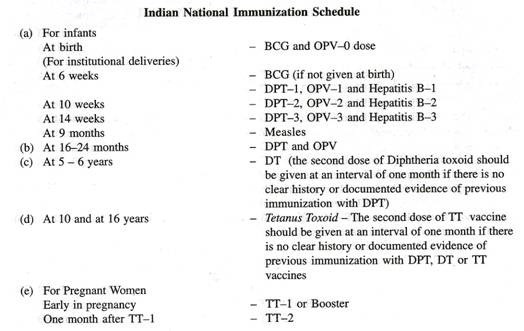Vaccines: Definition and Types of Vaccines!
Definition
Vaccine (L. vacca = cow) is a preparation/suspension or extract of dead/attenuated (weakened) germs of a disease which on inoculation (injection) into a healthy person provides temporary/permanent active/passive immunity by inducing antibodies formation.
Thus antibody provoking agents are called vaccines.
The principle of immunisation or vaccination is based on the property of ‘memory’ of the immune systems. Vaccines also generate memory-B and T cells that recognise the pathogen quickly. In snake bites the injection which is given to the patients contains preformed antibodies against the snake venom. This type of immunisation is called passive immunisation.
The process of introduction of vaccine into an individual to provide protection against a disease is called vaccination. In vaccination, a preparation of antigenic proteins of pathogens or inactivated/weakened pathogens (vaccine), is introduced into the body.
These antigens generate the primary immune response, and the memory В and T cells. When the vaccinated person is attacked by the same pathogen, the existing memory T or В cells recognise the antigen quickly and attack the invaders with a massive production of lymphocytes and antibodies.
Vaccination and immunisation are two different processes. Vaccination only refers to the administration of a vaccine or toxoid, while immunisation is the process by which the body produces antibodies against the vaccine preventable diseases through administration of specific vaccines. These are used to protect us and our domestic animals against viral and bacterial diseases.
Toxoid is a modified bacterial toxin that has been made nontoxic but retains the capacity to stimulate the formation of antitoxin.
Types of Vaccines:
There are several basic types of vaccines. Some vaccines are described here.
1. Attenuated whole-agent vaccines use living but attenuated (weakened) microbes. Examples of attenuated vaccines are the Sabin polio vaccine and those used against measles, mumps and rubella (MMR). The widely used vaccine against the tuberculosis bacillus and certain of the newly introduced, orally administered typhoid vaccines contain attenuated bacteria.
2. Inactivated whole-agent vaccines use microbes that have been killed. Inactivated virus vaccines used in humans include those against rabies, influenza and polio (the Salk polio vaccine). Inactivated bacterial vaccines include those for pneumococcal pneumonia, cholera, pertussis (whooping cough) and typhoid.
3. Toxoids which are inactivated toxins, are vaccines directed at the toxins produced by a pathogen. Examples. Vaccines against tetanus and diphtheria.
4. Subunit vaccines use only those antigenic fragments of a microorganism that best stimulate an immune response. Subunit vaccines that are produced by genetic modification techniques, meaning that other microbes are programmed to produce the desired antigenic fraction, are called recombinant vaccines. For example, the vaccine against the hepatitis В virus consists of a portion of the viral protein coat that is produced by genetically modified yeast.
5. Conjugated vaccines have been developed in recent years to deal with the poor immune response of children. The polysaccharides are combined with porteins such as diphtheria toxoid. This approach has led to the very successful vaccine for Haemophilic influenza type b, which gives significant protection.
6. Nucleic acid vaccines or DNA vaccines are among the newest and most promising vaccines, although they have not yet resulted in any commercial vaccine for humans. Experiments with animals show that plasmids of “naked” DNA injected into muscle results in the production of the protein encoded in the DNA. (The “gene gun” method for injecting nucleic acids into plant cells is described in Chapter 11).
These proteins stimulate an immune response. A problem with this type of vaccine is that the DNA remains effective only until it is degraded. Indications are that RNA, which could replicate in the recipient, might be a more effective agent.
Vaccines are also classified as follows.
1. First generation vaccines:
These are produced by conventional methods, e.g., small pox vaccine, Salk’s polio vaccine.
2. Second generation vaccines:
These are prepared with the help of genetic engineering technique, e.g., vaccines against Hepatitis В and Herpes virus.
3. Third generation vaccines:
These are synthetic vaccines which are under trial.
Vaccines under study:
Vaccines against Malaria, Leprosy, Herpes, Hepatitis C, AIDS, Dental caries, etc. are under study.
Immunisation and Pregnancy:
The question of whether immunisation of a pregnant woman presents any danger for the foetus is frequently raised. Ideally, immunisation should be performed before gestation, since some vaccines are not perfectly safe during pregnancy. Pregnant women are however, often vaccinated either because they travel to foreign countries or when an epidemic occurs.
Vaccines which are safe during pregnancy are tetanus, influenza, inactivated poliomyelitis, cholera and hepatitis B.
Vaccines which are to be avoided during pregnancy are small pox vaccine, oral poliomyelitis vaccine and rubella vaccine.
